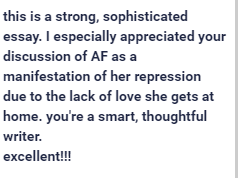Writing has always been something I particularly enjoy doing, and I have found in my own life that writing is a great outlet for the expression of creativity. Writing is a meaningful and thought-provoking artistic medium that often goes under-appreciated because contemporary society has put a much greater focus on reading and being the idealized ‘book-worm.’ This grossly undermines the influence of writing, and with the exception of a few people, reading should only be enforced when needed for the sake of comparison, such as the Freudian texts. I would even make the argument that this naive perception of English studies plays a large role in the staggering increase of students who have the inability to write or speak with confidence. Regardless of this, my own experience with writing is founded in detail and was enriched by this courses’ focus on text-to-text comparisons. Through the literacy narrative, exploratory essay, and critical research paper respectively, I have come to a greater understanding of in-depth literary analysis.
Literacy Narrative
The literacy narrative acted as an introduction to the concept of in-depth analysis, by taking a single artwork and having us then write an entire essay on it. It was from this that the importance and appreciation of subliminal detail became integrated with the course. The artwork depicting Ruby Bridges was meant to inspire a generation and serve as an icon for the progression away from segregation. This stark contrast is made apparent when we come to understand the implications of the political cartoon that was made retrospectively. Despite having not a single sentence in each of the picture, save for the titles, we were each able to draw our own conclusions on how this comparison influenced us. Being all too familiar with political satire myself, I tried to analyze the intent rather than the content. In the age of mass media and viral media, the unarguably most effective means to spread something is to make it as offensive as possible. It is in this way that tabloids and even ‘credible’ outlets present their information to attract as many viewers as possible for maximum exposure. With this immoral intent, political cartoons such as the one we analyzed focus more on inciting a reaction rather than proving a point. (Ironically enough, I would make the argument that South Park is a perfect example of how to create modern political satire: see Trey Parker and Matt Stone’s perspective on ‘either everything is funny or nothing is.’)
/cdn.vox-cdn.com/uploads/chorus_image/image/53279515/headshots_1487274490357.0.jpg)
Exploratory Essay
The exploratory essay was our first attempt at integrating our newfound understanding of the Freudian concepts, such as repression, and applying them to another text. I chose “Where Are You Going, Where Have You Been?” by Joyce Carol Oates particularly because I already had some exposure to it in senior year of high school. Yet despite my previous exposure, it had little to no effect on my ability to write this essay. This is because instead of analyzing the symbolism within the story, we had to psychoanalyze the story through a ‘Freudian lens.’ This new perspective opened an entirely new pathway to explore through the story, since we could then consider how the inner-most desires of the protagonist influenced the events of the story. It can also be argued that the events are all meant to be some representation of those desires and her fears, such as her desire for affection but her fear that these men might take advantage of her. Arnold Friend, the antagonist of the story, can be seen as this fear materialized, which then overcomes her mentally through supernatural means, proving that Friend does not exist within reality. I received this comment as feedback for my analysis of Arnold Friend which helped reassure me that I was correctly interpreting the concept of repression as discussed in the five lectures by Freud.
 Critical Research Paper
Critical Research Paper
Unfortunately, I feel as if the CRP was my weakest essay from this semester, despite it being my final. I felt this way because I took on the task of explaining the psychoanalytic aspects of The Count of Monte Cristo, by Alexandre Dumas. There is so much content from the unabridged version of this story to analyze that I had to cut down much of what I wrote in order to fit within the page limit, and I ended up cutting out everything that didn’t directly or indirectly relate to a Freudian concept in some way. After all this downsizing, I was left with an essay that focused entirely on the comparison to Freud, without giving too much context to the story such as its resolution. If I were to consider that the reader had actually read the story, my mind would have been more at ease. I also felt concerned about how my inclusion of the individual in society seemed out of place, since there was no seamless way to incorporate it into the text. Despite all of these worries, I thoroughly enjoyed writing about The Count since it is my favorite novel of all time, and I feel that the Freudian psychoanalysis I made of The Count was concrete and accurate.
Reflections
For each of my reflections I would write them immediately following the essay and with little to no break. I did this not only to get it out of the way, but also to ensure that I was only writing a stream of consciousness that showed how I really felt about what I wrote. The reflections were more effective in this way because if there was any major outlying issue with the paper I would go back to resolve it. I also felt that reflections were useful in general because they forced us to acknowledge the course learning outcomes and point out which aspects we were practicing at which point in the course.



